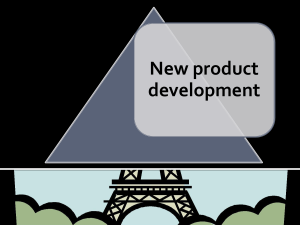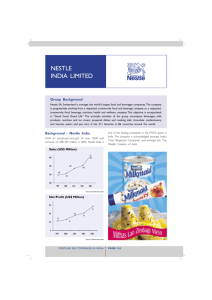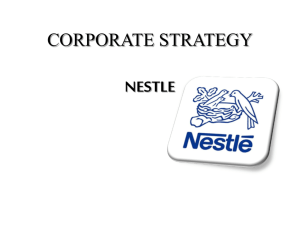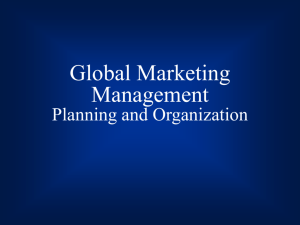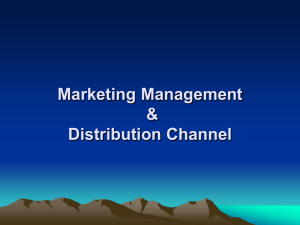Nestlé - WordPress.com
advertisement
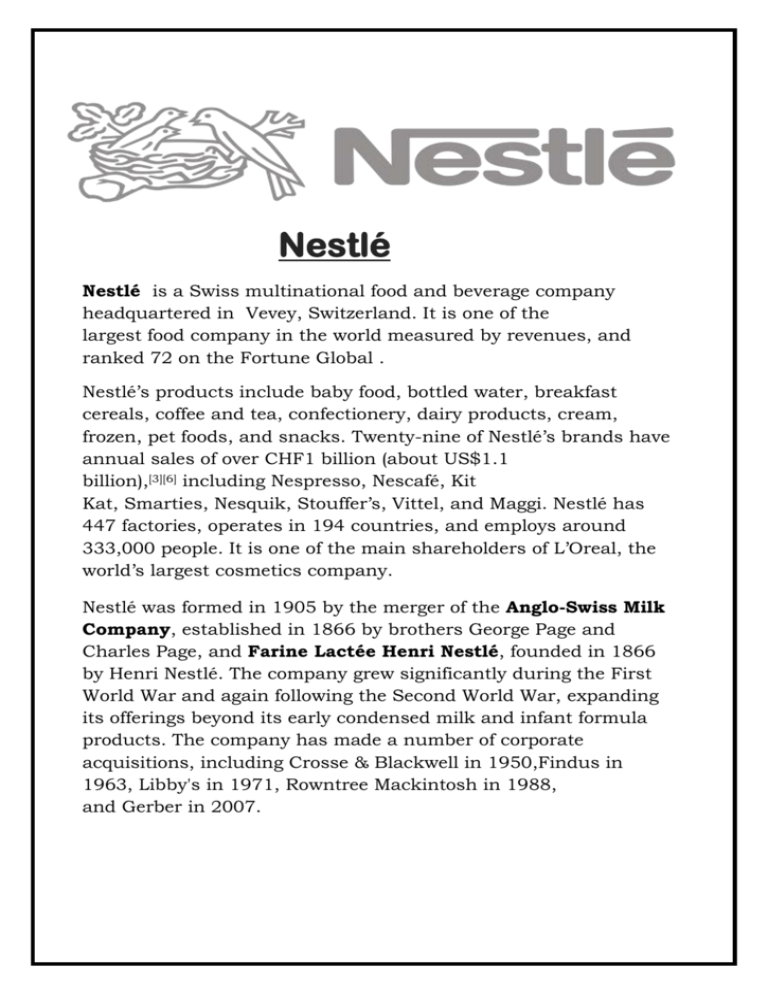
Nestlé Nestlé is a Swiss multinational food and beverage company headquartered in Vevey, Switzerland. It is one of the largest food company in the world measured by revenues, and ranked 72 on the Fortune Global . Nestlé’s products include baby food, bottled water, breakfast cereals, coffee and tea, confectionery, dairy products, cream, frozen, pet foods, and snacks. Twenty-nine of Nestlé’s brands have annual sales of over CHF1 billion (about US$1.1 billion),[3][6] including Nespresso, Nescafé, Kit Kat, Smarties, Nesquik, Stouffer’s, Vittel, and Maggi. Nestlé has 447 factories, operates in 194 countries, and employs around 333,000 people. It is one of the main shareholders of L’Oreal, the world’s largest cosmetics company. Nestlé was formed in 1905 by the merger of the Anglo-Swiss Milk Company, established in 1866 by brothers George Page and Charles Page, and Farine Lactée Henri Nestlé, founded in 1866 by Henri Nestlé. The company grew significantly during the First World War and again following the Second World War, expanding its offerings beyond its early condensed milk and infant formula products. The company has made a number of corporate acquisitions, including Crosse & Blackwell in 1950,Findus in 1963, Libby's in 1971, Rowntree Mackintosh in 1988, and Gerber in 2007. Nestlé India : Nestle relationship with India date back to 1912,when it began trading as the Nestle Anglo-Swiss condensed (Export ) Limited, Importing and selling finished product in Indian market. After India’s independence in 1947 the economic policies of the Indian Government emphasized the need for local production soon they started the production here in India. Nestle setup his first factory in 1961 in Moga Punjab. NESTLÉ India manufactures products of truly international quality under internationally famous brand names such as NESCAFÉ MAGGI MILKYBAR KIT KAT BAR-ONE MILKMAID NESTEA and in recent years the Company has also introduced products of daily consumption and use such as NESTLÉ Milk, NESTLÉ SLIM Milk, NESTLÉ Dahi and NESTLÉ Jeera Raita. NESTLÉ India is a responsible organisation and facilitates initiatives that help to improve the quality of life in the communities where it operates. Nestlé Products: Nestlé has 8,000 brands, with a wide range of products across a number of markets, like coffee bottled water, milkshakes and other beverages, breakfast cereals, infant foods, performance and healthcare nutrition, soups and sauces, frozen and refrigerated foods pet food. Nestlé held 29.7% of the shares of L'Oréal, the world's largest company in cosmetics and beauty. Its brands including Garnier, Maybelline, and Lancôme as well as The Body Shop stores. Vision and Mission: Nestle mission and vision is to bring consumers foods that are safe of high quality and provide optimal nutrient to meet physiological needs. Nestle helps provide selections for all individual taste and lifestyle preferences. Business Objectives: Nestle follows some business principle in all over the world: 1. Main objective is to manufacture products in such a way as to create value and build and sustain Consumers, employers, shareholder and business partners. 2. Nestlé does not favour short term profit at the expense of long term business development. 3. Nestle is a conscious of the fact the success of the corporation is a reflection of the management and employers. Therefore selection of right people ongoing training and development is required. 4. It recognise that its consumer have a sincere and legitimate interest in the behaviour beliefs and action of the company behind brands, in which they place their trust and that without its consumer the company would not exist. Organisational Structure of Nestle:Organizational structure is the formal framework by which jobs tasks are divided, grouped, and coordinated. Nestlé is a function-based organization. The tasks are divided into separate jobs and then these jobs are grouped together under different departments. Market Strategies of Nestle:1. Nestle Advertisement is used in most suitable language in different countries. 2. Product line method is used by the company for its Establishment in the market. Quality and nutritional value are the essential ingredients in all brands of Nestlé. Millions ofpeople prefer Nestlé products every day, happy with the addition to their wellness that they bring. Nestlé is giving its products in -10 different categories of food with 75 brands . These food categories with product lines are: Baby food (Cerelac), •Beverages (Nescafe liquid, MILO, Buddy, Orange juice, •Breakfast cereals, Chocolate and confectionery (KitKat), •Dairy Products (Milkpak, NIDO, EveryDay,), •Prepared food (Maggi noodles), •Bottled Water (Nestlé Pure Life) Nestlé offers following Product lines in India. 3. Maintains consumers relationship build more and more trust and proves it loyalty towards the consumer . 4. Nestle maintains its employee relation for better profit and sales in the market. 5. Corporate social relationship is emphasied by the company.(member of PETA) 6. Committy realtion is maintained for better profit sales and place in the market. Ruler development programme done by the company -Provides education in ruler area till now 18,500 girls child have been provided education under Nestle. -About 48 sanitation facilities have been provided in ruler areas of India. 7. Supporting employees and their families. 8. Do Partnership for healthier tomorrow. 9. Above all the things is done by the Nestle to maintain its Image show case its culture and increase its brand value in the market to earn profit and sales. Sales And Profit and Investment : Off 2014. Sales of CHF 92.2 billion, +2.7% 4.6% organic growth, 3.1% real internal growth Trading operating profit margin up 20 basis points to 15.2%, up 40 basis points in constant currencies Group results:- In 2014 Nestlé’s sales increased by 2.7% to CHF 92.2 billion, impacted by negative foreign exchange of 3.7%. Organic growth was 4.6%, composed of 3.1% real internal growth and 1.5% pricing. added 1.8% to sales. The Group’s trading operating profit was CHF 14.0 billion, representing a margin of 15.2%, up 20 basis points versus last year, and up 40 basis points in constant currencies. Nestlé Continuous Excellence again delivered more than CHF 1.5 billion in efficiencies in all areas of the business. This, together with reduced structural costs, enabled us to increase thier brand support and absorb higher restructuring costs. Net profit was CHF 10.0 billion down slightly due to the costs of portfolio restructuring and the currency impact. As a consequence, reported earnings per share were CHF 3.14, down 2.2%.Underlying earnings per share in constant currencies were up 11.0%. The Group’s operating cash flow continued to be strong at CHF 15.0 billion. The Nestlé Group’s organic growth was broad-based, 5.1% in the Americas, 0.8% in Europe and 7.4% in Asia, Oceania and Africa. Our business in developed markets grew 1.0%, achieving sales of CHF 51.4 billion. Our emerging markets business grew 9.3%, delivering sales of CHF 40.8 billion. Profit And Loss of Nestle in India. 12,000.00 10,000.00 8,000.00 2014 6,000.00 2013 2012 4,000.00 2,000.00 0.00 Sales Turnover Net Sales Total Income 2014 Income Sales Turnover Excise Duty Net Sales Other Income Stock Adjustments 9,854.84 0.00 9,854.84 85.81 67.43 2013 9,101.05 0.00 9,101.05 96.90 -105.32 2012 8,614.15 279.62 8,334.53 -1.66 92.02 Total Income 10,008.08 9,092.63 MAGGI: - Its an international product instant soup and noodles owned by Nestle from 1947. The company was founded by Julius Maggi in Switzerland. -In India , Maggi instant noodles were very popular. Nestle has a 90% share in India. In June 2015, it was reported in India that tests had found high amounts of lead and MSG in Maggi noodles, and FSSAI ordered country-wide withdraw and recall for all 9 variants of Maggi Instant Noodles and Oats Masala Noodles. Due to Maggie Nestle had to face many issues such as criticism of its advertising not adhering to marketing regulations in developed countries, and making misleading claims in developing countries. 8,424.89 - In October 2008 Nestlé mistakenly aired a commercial meant for Bangladeshi television on British TV. The advert made false claims that the noodles would "help to build strong muscles, bone and hair". The British Advertising Standards Authority said that the advert did not abide by the new EU consumer protection legislation, by which advertisers have to provide proof of health claims. Market of Nestle(MAGGI).. -Market consists of people or organizations with needs to satisfy, money to spend, and willingness to spend it. -Markets are made up of current and prospective customers, defined as any person or group with whom a marketer has an existing or potential relationship. Analysis of Market:Analyzing the market means getting the information about the current market trends. The needs and wants of the customers are identified, the availability of the products is monitored as well as information about the competitors is gathered through this analysis. The image of the product in the minds of the customers is also judged and then on the basis There are different ways, which are adopted by Nestlé to get the information of the market. -Sales Department: Sales department is a primary source of getting the information about the market. They actually visit the market and find out that who are the competitors, and what strategies they are adopting. They also collect the complaints of the customers and make sure the availability of the product in the markets. -Customer Service Department: For Every product there is customer service department. This is head office based department i.e. every head office has its own department. - In this department, customer’s complaints are collected which are gathered through the sales force or directly submitted by the customers. Then batch number is assigned to these complaints and is transferred to the Marketing Department. - If Marketing Department can’t be able to solve the problem then these complaints moved to the Quality Assurance Department, which is working in the Factory. - Research and Development Department: In Nestlé, R&D departments are localized. Its head office is in Switzerland. Nestlé has divided the whole world into 3 zones each has its own R&D. 1. America 2. Europe 3. A.O.A. (Asia Oceania Africa) -The R&D in America Zone is in America itself, in Europe Zone, it is in France and in A.O.A. Zone it is in Australia. - Suppliers and distributors: To know about the market Nestlé India limited has established the close relationship with their suppliers who provide the raw material and the distributes who distribute the product in the market. As these both have an up-to-date knowledge about the market as they have a close interaction with the customers and also with the competitors. STP (Segment, Target and Position) Market Segmentation: Market segment consists of a large identifiable group within a market with similar wants, purchasing power, geographical location, buying attitudes, or buying habits. In a total market, there is always some diversity among the buyers. Within same general market there are group of customers, market segments , with different wants, buying preferences, product use behaviour. In some markets these differences are relatively minor, and a single marketing mix can satisfy benefits sought by the consumer. The market segment is based on need based and it’s targeted for everyone who care s for his/her life and wants to maintain good health. Target Market: After the company has segmented a market, management must next select one or more segments as its target markets. The company can select any one of the tree strategies i.e. Market Aggregation, single segment concentration, or multiple segment targeting. The target market of nestle (maggi) consists of lower class to upper class and mainly children. When positioning a product the marketer wants to convey benefits most desired by the target market. -kids -youth -office goers -working women -health conscious people. Segmentation: • Positioning Apart from the traditional positioning for kids, manufacturers are now targeting the adult consumers as well by leveraging on the convenience aspect which has become more important given the changing employment patterns. • Age • Lifestyle of youth CURRENT STATUS OF MAGGI:• Even today, Maggi enjoys a market share of over 70%, despite the presence of a number of other brands. This decade old dominance, however, is set to be shaken up. which is valued at around 250 crores. • According to Datamonitor estimates, the instant noodle market in India is worth over Rs 1,300-crore and is growing at a phenomenal rate of over 17-20% per year How Nestlé positioned Maggi ? Initially Nestle tried to position the Noodles in the platform of convenience targeting the working women. But it found that the sales are not picking up despite heavy promotion .Research then showed that Kids were the largest consumers of the brand. Realising this, Nestle repositioned the brand towards the kids using sales promotions and smart advertising. Maggie has always positioned itself as “Healthy noodles” conducted a survey and found out that maggi is liked by children Mummy bhook lagi Bas 2 min Tasty bhi healthy bhi Positioned itself as a ‘Fast to cook, good to eat’ snack Managment Strategies of Maggi to stablish in market:4P’s of Evaluations (a) Price. -Affordable by all income group. -Diffrentiated packaging. -Lower price point Strategy. -Multi packs at cheaper price per noodles. (b)Place -Wide distribution network. -Limited penetration in rular areas -The company had complex supply chain processes. -Target hawker/roadside eating joints. -Easily available in all retail stores. (c)Product -Quality -Model and Size -Packing -Brands -Services (d) Promotions. -Nestle also followed up by the launces of ad campaign. -Nestle was focusing on the ad based on children’s taste and health -Slowly Maggi Started focusing on family rather than just kids. -In additional to promotional activities Maggi associated it self with main stream television programme and advertised heavily on kid programme and channels. MAGGI SWOT ANALYSIS:Swot analysis of Maggi brand clearly indicates The strength of maggi As a brand in Indian Market. The Brand was the leader in the category of the Noodles with strong customer loyalty. Intensive distribution of Maggi was shown in the urban areas of the country. The major threats of the brand indicates that maggi has made several attempts to revamp itself as a “healty product”. But before the abolition or banning of the product the preservence towards the tagline was low. STRENGTH:- It was -Establised Family brand. -Strong Global corporate Brand -Speciliased in food processing category marketing and distribution in urban areas. -Market Leaders. -Nestle symbolization of warm, family and shealter. -Innovative flavours for Indian Taste Buds. WEAKNESS:-It was Generic brand to noodles in India -Low rural market was there. -uniform brand for all food brand category. - It was Heavily dependent on one flavour. OPPERTUNITY:-it was -Growing package and canned food market in India by 15% annually -High brand awareness of Indian customers. _unexploited rural market. -Increasing no of working youth THREATS:-Single product focused competitors like wai wai -less entry barriers in the market Segment for product category -competitive pricing -strong presence of regional competitors. Case Study:- -In May 2015, Food Safety Regulators from Uttar Pradesh, India found that samples of Maggi 2 Minute Noodles had unexpectedly high levels of monosodium glutamate, as well as up to 17 times the permissible limit of lead. On 3 June 2015, the New Delhi Government banned the sale of Maggi in India -New Delhi stores for 15 days due to these findings. On June 4, 2015, the Gujarat FDA banned the noodles for 30 days after 27 out of 39 samples were detected with objectionable levels of metallic lead, among other things. -Assam had banned sale, distribution and storage of Maggi's "extra delicious chicken noodles" variety for 30 days since June 4, 2015 after tests carried out at the state public health laboratory concluded the particular variety to contain -Added MSG and excessively high lead content. Some of India's biggest retailers like Future Group which includes Big Bazaar, Easyday and Nilgiris have imposed a nationwide ban on Maggi. Thereafter multiple state authorities in India found an unacceptable amount of lead and it has been banned in more than 5 other states in India.On June 4, 2015 the government of Tamil Nadu also banned maggi due to unacceptable amount of lead and other components. On June 5 the Andhra Pradesh Government Banned Maggi .Maggi will not be banned in Karnataka for now, declared minister for health and family welfare U T Khader during a press meet on June 26. On June 5, 2015, Food Safety and Standards Authority of India (FSSAI) ordered a recall of all nine approved variants of Maggi instant noodles and oats masala noodles from India, suggesting them unsafe and hazardous for human consumption. On the same day, Food Safety Agency of United Kingdom launched an investigation to find levels of lead in Maggi noodles. On June 6, 2015 the Central Government of India banned nationwide sale of Maggi noodles for an indefinite period. Nepal indefinitely banned Maggi over concerns about lead levels in the product. Maggi noodles has been withdrawn in five African nations- Kenya, Uganda, Tanzania, Rwanda and South Sudan by a super-market chain after a complaint by the Consumer Federation of Kenya. It was revealed later that the United States Food and Drug Administration (FDA) had refused import of the noodles in January 2015 on grounds similar to the reasons for ban in India.Ironically, the Bombay High Court allowed the export of Maggi while the ban in India remained. FIRs against Bollywood Maggi Brand Ambassadors Amitabh Bachchan, Madhuri Dixit & Preity Zinta were lodged at a local court, asking the authorities to arrest them if required. Maggi row hits Nestle revenue:Due to ban on Maggie Nestle faced a big loss . The ban announced during market hours led to a 9% drop in Nestle, extending the fall to 11.7% since the UP government first ordered a recall of Maggi packs over food safety concerns. Around 1,500 workers involved in manufacturing of Maggi in India have been 'impacted' by the stoppage of production after ban of the instant noodles brand. Nestle India’s flagship Maggi noodles contribute 25% of the company’s total revenues and enjoy 50%-plus market share. Some retailers said Maggi sales fell nearly 30% after the issue came up, though exact figures were not immediately available. Trade experts say Maggi’s troubles could partly boost sales of rival brands, however the noodles segment as a whole could get hit if the issue played out over a longer term. FMCG giant ITC has been aggressive over the past several quarters, with its Sunfeast Yippee brand of noodles garnering 15% market share. Nestle India reported 23% growth in net profit in the January-March quarter but volumes were flat. “Maggi was perhaps the only growing brand (in volumes) for Nestle India last quarter. Following this controversy, we feel the company’s volume growth in the second quarter (April-June) could even be negative,” said an analyst at a domestic brokerage. Analysts say Nestle India’s earnings could be under pressure for a couple of quarters. The Nestle India spokesperson said the company was making efforts to gather more information to investigate that matter Maggi is Nestle’s major revenue contributor which scale 30-35% and sales of about 200 Crores of monthly sales. Before coming to what should be done ,its better to know what had happened till now ,here are some of the major areas to work on to over come this crisis 1. Loss of inventory of about 320 Crores (destroyed) 2. Loss in Stock of Nestle of about 15-20% 3. Major loss of Customer Trust (Most Essential thing lost) Steps taken by Nestle :Nestle India Takes Baby Steps Towards Damage Control: Issued in public interest or more to say in its consumer's interest, the advertisement gives details on where and how the company can be contacted in case any one wishes to return their Maggi noodles packets. The advertisement reads as follows: "Our company representative will get in touch to collect these MAGGI Noodles packs and reimburse you the value of the collected packs. This is what Nestle had to say about the matter: “We do not add MSG to MAGGI Noodles and glutamate, if present, may come from naturally occurring sources. Food regulators in India also do not specify any limit for the presence of MSG / Glutamate,” a Nestle spokesperson said. “We are surprised with the lead content supposedly found in the sample. We monitor the lead content regularly as part of regulatory requirements, and tests IT Takes Maggi Noodles Off the Shelves, Saying It Will be Back Soon. Suggestions:According to me Maggi needs to really evaluate thier PR & Brand Managers. The first news about Maggi being unsafe came out on May 6th 2015. The PR and Brand managers were sleeping till the 16th of May when the crisis blew up in thier face. A brand that contributes 30% of it's revenues and has 70% Market share and this is how thier managers respond. Really pathetic. The responses of the conservative Swiss company to the crisis, however, have left many management analysts baffled. few things that Nestle India should have done, but it didn’t . #1 Nestle allowed its icon (Maggi) to be the target of a controversy that questioned its reputation. From a marketing standpoint guarding against such slip-ups figure high on DON’TS list. #2 You don’t need to be a marketing guru to tell you which P was important for Nestle. It’s the Product (Maggi), which the company should have attached the most value and significance. #3 Being conservative is good, but not quite in a crisis involving its most iconic product. Reaching out proactively through media should have been the first boxes to tick in the To Do list. Avoiding media is a strict NO . #4 Nestle continues to remain in Its argument: Maggi is safe. But an offer to recall or withdraw existing stocks from shop shelves immediately after the controversy broke out could have prevented things getting out of hand. #5 Nestle’s representatives have been hardly seen either at retail stores or popular vends offering to clear the air. Neither has it come out with any unusual videos or campaigns to educate loyal patrons. Key Information: India is Maggi's biggest market in the world. 30 per cent of Nestle India's revenue is from Maggi. For 32 years, Maggi has dominated India's instant noodle market. Maggi has been pitched as a healthy food option. Hon’ble Bombay High Court Allows MAGGI Noodles to be Exported on 30 June 2015 Indian court said Tuesday that Nestlé SA could export batches of Maggi 2-Minute Noodles made in India, but still could not sell them in the country. Sales of the wildly-popular snack were blocked due to across India this month after regulators said they found elevated levels of lead in some samples, an allegation the company denies. Nestlé challenged the nationwide ban in court. In the latest hearing Tuesday, Nestlé asked the Bombay High Court for clarity on whether it is permitted to export the Maggi noodles, even though regulators had not barred the company from sending the product abroad. Nestlé’s Indian arm exports Maggi noodles to the U.S., U.K., Canada and Singapore, among other countries. Noodles exported to these countries and those sold in India are produced in the same facilities. Nestlé’s five noodle factories were shuttered amid heightened concern over the safety of the snack. The court’s blessing could mean the Swiss company resumes noodle production, as long as the products are for sale overseas. Still, the court’s decision may appear rather odd to some consumers: Question still remain unanswered Why is Nestlé barred from selling its noodles in India but not abroad? Graph/Chart of Survey: how often you use toeat Maggie Noodles? Twice a week thrice a month daily very rarely Do you trust Nestle Product Any More? Yes No Some of the Product All the products except Maggi will you trust Maggi again? Yes no Do you want Maggi back? yes no Now after this big crises with Maggi . Do you now think and hesitate in buying Nestlé’s other products? Yes No Sometimes After Maggie which noodles you are preferring to eat? yipee Knor soupy Top Ramen ching's Secret How would do you rate Nestle as compare to other Companies and products? Far most better better slightly Not at all. Are you satisfied with the variety of Products provided by Nestle? yes no somewhat CONCLUSION/RESULT: From this Study The Result give a real picture about the Scenario to Nestle Maggi Noodles. The above graph shows/indicate the level of loyalty among the customers upon the Nestle Maggi Noodles has been vanished. Beacuse of the Maggi The other product of Nestle brand too has to face the hue crisis in the market off India. Once upon a time Nestle India was riding on the success Of noodles but no Nestle is Change its Strategy and policies of marketing as to stand in the market of India such that After the huge Crisis of Maggi it has faced a loss off thousands core as well as the reputation in the eye of customer and trust and loyalty which Nestle was all about did not have same . To stand up again in the Indian Market good step is all needed by the Nestle Company. ACKNOWLEDGMENT I would like to express my special thanks of Gratitude to my Faculty Guide (Mr. Sibby Mathew) As well as other faculties who gave me the golden opportunity to do this Wonderful project on (BRAND STUDY OF NESTLE AND IMPACT OF MAGGI CRISIS ON IT.) Which also helped me in doing a lot of Research and i came to know about so many new things I am really thankful to them. Secondly I Would also like to thank my parents and friends who helped me a lot in finding this project within the limited time frame. To Whom So Ever It May Concern This is to certify that Ms/Mr. ________________________has worked on the term project_____________________________________________ _________________________________ under my supervision. This is his/her original work. I wish her all the best. Signature:___________________ Date: ___________________ Name:___________________ Designation:__________________ INDEX NESTLE INTRODUCTION NESTLE INDIA NESTLE PRODUCTS ITS VISION AND MISSION BUSSINES OBJECTIVE ORGANISATIONAL STRUCTURE OF NESTLE MARKETING STRATEGY OF NESTLE SALES PROFIT AND LOSS MAGGI (ITS INTRODUCTION) ANALYSIS OF MARKET TARGET AUDIENCE PRODUCT PALCEMENT SWOT ANALYSIS OF MAGGI CASE STUDY OF MAGGI STEPS TAKEN BY NESTLE FOR ITS BRAND BULIDING LOSS OF NESTLE BY MAGGI SUGGESTION TO NESTLE KEY IMFORMATION SURVEY CONCLUSION/RESULT BIBLIOGRAPHY. BIBLIOGRAPHY BOOKS AND JOURNALS: -TIME OF INDIA -HINDUSTAN TIMES DANIK BHASKAR ELETRONIC SOURCES: -TELEVISION (NEWS CHANNELS) SOCIAL NETWEORKING: -FACEBOOK -TWITTER -YOUTUBE AMITY UNIVERSITY JAIPUR SESSION 2013-2016 SUMMER TERM PROJECT ON(BRAND OF STUDY OF NESTLE AND IMPAC OF MAGGI ON ITS BRANDING.) SUBMITTED TO: BY: MR. SIBBY MATHEW AMAAN SUBMITTED BUSHRA BJMC-V Did survey On Nestle and Maggi Prepared 15 questions based on Nestle and Maggi Number of people attempted :55 Age grope basically youth. Gender: Both male and female . Sales in billion CHF 95 90 85 80 75 Sales in billion CHF
